Choosing antioxidant-packed herb infusions is a smart move for your wellness. These infusions help neutralize harmful free radicals, reducing oxidative stress and boosting your immune system. They can also fight inflammation linked to chronic diseases and promote healthy skin. Ingredients like green tea, turmeric, and ginger are rich in antioxidants, making every sip beneficial. Plus, you can create your own blends to suit your taste and health goals. So, not only do you enjoy a flavorful drink, but you also support your overall health. Keep exploring these herbal options to reveal more benefits you might not know about.
Benefits of Antioxidants
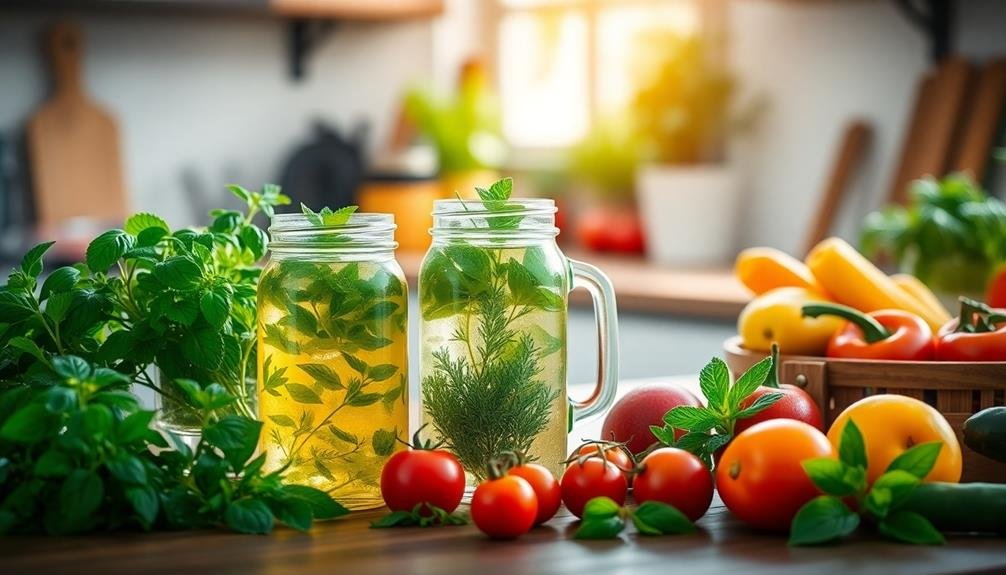
Antioxidants play an essential role in maintaining your overall health by neutralizing harmful free radicals in your body. These unstable molecules can cause oxidative stress, leading to cell damage and increasing your risk of chronic diseases. By incorporating antioxidants into your diet, you can help protect your cells and promote better health.
One of the primary benefits of antioxidants is their ability to support your immune system. A strong immune response helps you fend off infections and illnesses, keeping you feeling your best.
Additionally, antioxidants can reduce inflammation, which is linked to various health issues, including heart disease and arthritis. By lowering inflammation, you can enhance your overall well-being.
Antioxidants also contribute to healthy skin. They help combat signs of aging by protecting against sun damage and improving skin elasticity. You'll notice a more radiant complexion as you incorporate antioxidant-rich foods and beverages into your routine.
Moreover, these compounds may even support brain health by reducing the risk of neurodegenerative diseases, ensuring you stay sharp as you age.
In short, incorporating antioxidants into your lifestyle can lead to numerous health benefits, enhancing your quality of life and longevity.
Popular Herbal Ingredients
Incorporating herbal ingredients into your diet is a fantastic way to boost your antioxidant intake and support your overall wellness. Many popular herbs pack a powerful punch when it comes to fighting oxidative stress. For instance, green tea is renowned for its high levels of catechins, which can enhance your body's defenses.
Another great choice is turmeric, thanks to its active compound, curcumin. This vibrant yellow herb not only adds flavor but also boasts significant anti-inflammatory and antioxidant properties.
You might also want to explore the benefits of rosemary, which contains rosmarinic acid, known for its impressive antioxidant capabilities.
Don't overlook the power of ginger either; it's not just a kitchen staple but also a source of gingerol, an antioxidant that may help reduce inflammation.
How to Create Blends
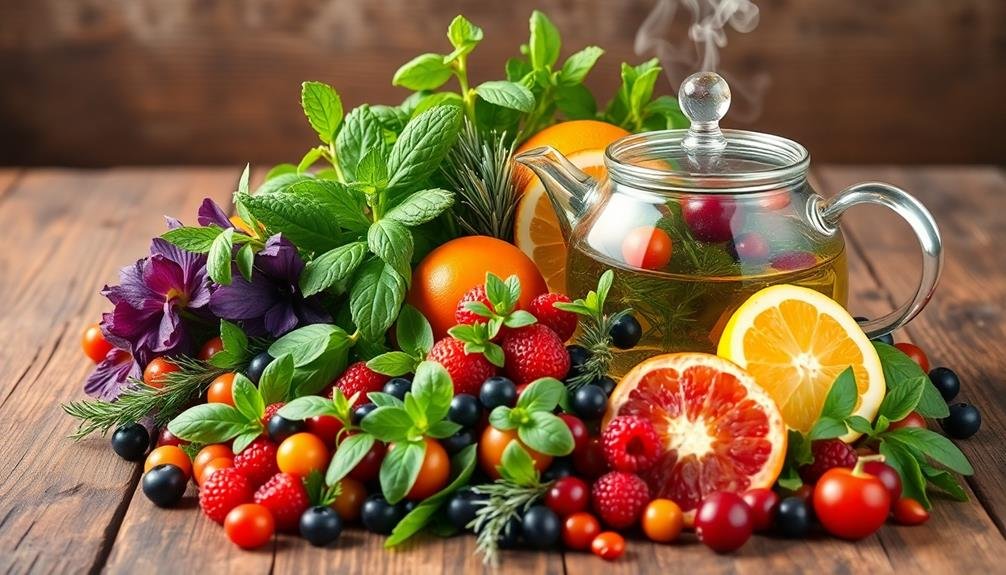
Creating your own herb blends starts with selecting the right herbs that complement each other's flavors and benefits.
Once you've chosen your herbs, you'll want to experiment with different blending techniques to find the perfect balance.
Here are some tips to help you craft delicious and nutritious herbal infusions.
Selecting the Right Herbs
Selecting the right herbs for your wellness infusions is an art that combines knowledge and intuition. Start by reflecting on the health benefits you're aiming for. Do you want to boost your immune system, reduce stress, or enhance digestion? Each herb carries its unique properties, so it's important to research which ones align with your wellness goals.
Next, think about the flavor profiles. Some herbs, like mint or chamomile, offer a revitalizing taste, while others, like rosemary or sage, can be more robust. Balancing flavors is key to creating a delicious infusion. You might prefer a soothing blend of chamomile and lavender for relaxation or a vibrant mix of ginger and lemon balm for a revitalizing pick-me-up.
Don't forget to reflect on the seasonality and availability of herbs. Fresh herbs can elevate your infusion, but dried options are often just as effective.
Experimentation is part of the process—try different combinations and adjust ratios according to your preferences. Trust your palate and intuition; the right blend will resonate with you, providing not just wellness benefits but also enjoyment in every sip.
Blending Techniques and Tips
When it comes to crafting flavorful herb blends, understanding the basics of pairing and balancing flavors is essential. You'll want to think about the dominant notes and how they can complement one another. For instance, pairing earthy herbs like rosemary with bright herbs like basil creates a delightful contrast.
Here's a simple table to help you visualize some effective combinations:
| Herb | Flavor Profile | Best Pairings |
|---|---|---|
| Basil | Sweet, aromatic | Oregano, thyme |
| Rosemary | Earthy, piney | Sage, garlic |
| Thyme | Earthy, minty | Basil, parsley |
Start by experimenting with small amounts of herbs in your blends. Remember, you can always add more, but it's tough to take away too much. Keep tasting as you mix, adjusting to achieve the flavor balance you desire. Finally, don't hesitate to get creative! Combining less common herbs can lead to unexpected and delightful results, enhancing both your palate and wellness journey. Happy blending!
Brewing Techniques
When brewing your herb infusions, paying attention to the ideal temperature can make a big difference in flavor and health benefits.
You'll also want to follow specific infusion time guidelines to extract the maximum antioxidants.
Optimal Brewing Temperature
Finding the ideal brewing temperature is crucial for extracting the full benefits of antioxidant-packed herb infusions. If you brew at the wrong temperature, you mightn't get the taste or health benefits you're aiming for. Generally, you'll want to stick to specific temperature ranges depending on the type of herbs you're using.
Here are some tips to help you achieve that perfect brew:
- Leafy herbs: Brew between 190°F to 212°F (88°C to 100°C) for best flavor and antioxidant extraction.
- Roots and seeds: A lower temperature of 180°F to 200°F (82°C to 93°C) may work better to avoid bitterness and preserve delicate compounds.
- Flowers: Aim for around 200°F (93°C) to guarantee you capture the full essence without losing beneficial properties.
Using a thermometer can help you monitor the temperature accurately, but if you don't have one, you can bring water to a boil and let it sit for a minute or two before pouring it over your herbs.
Experimenting with temperature will help you discover the best flavor and health benefits for your specific herb infusions. Happy brewing!
Infusion Time Guidelines
Brewing time is just as important as temperature for maximizing the health benefits of your herb infusions. The right infusion time allows the beneficial compounds in the herbs to seep into the water, ensuring you get the most out of your brew. Too short, and you might miss out on key nutrients; too long, and the flavors can become bitter.
Here's a quick guide to help you determine the best infusion times for various types of herbs:
| Herb Type | Recommended Infusion Time |
|---|---|
| Delicate Herbs | 2-5 minutes |
| Leafy Greens | 5-7 minutes |
| Sturdy Herbs | 7-10 minutes |
| Roots & Barks | 10-15 minutes |
For delicate herbs like chamomile, aim for shorter brewing times to preserve their subtle flavors. On the other hand, sturdy herbs such as rosemary benefit from longer infusions, allowing their robust flavors and antioxidants to fully develop. Adjust the time based on your taste preferences and the specific health benefits you're seeking. Enjoy experimenting to find your perfect brew!
Herb Selection Tips
Selecting the right herbs for your infusion is essential to enhance both flavor and health benefits. Here are some tips to help you choose the best herbs for your wellness journey:
- Know Your Goals: Consider what health benefits you're aiming for. For example, if you're looking for relaxation, chamomile or lemon balm might be ideal. For immune support, think about echinacea or elderberry.
- Fresh vs. Dried: Fresh herbs bring vibrant flavors and aromas, while dried herbs offer concentrated benefits. If you can, try using a combination of both for a balanced infusion.
- Experiment with Flavors: Don't shy away from mixing herbs. Combining mint with ginger can create a revitalizing yet spicy infusion, while lavender paired with chamomile offers a soothing experience.
Once you've selected your herbs, be mindful of the steeping time and temperature to maximize their antioxidant properties.
With these tips in mind, you'll be well on your way to crafting delicious and health-boosting herb infusions. Enjoy the process and let your taste buds guide you!
Health Benefits of Infusions
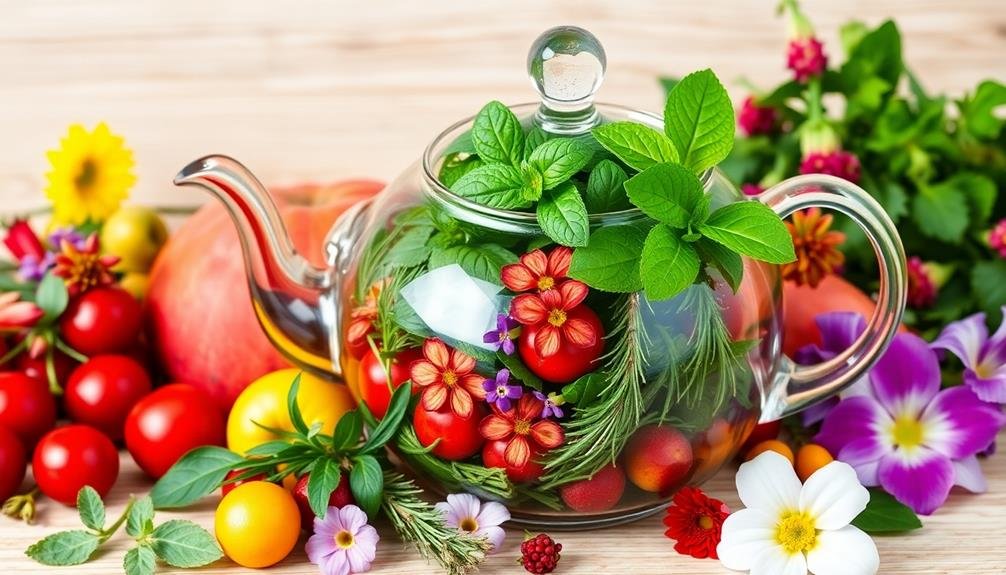
Herb infusions offer a treasure trove of health benefits, making them a popular choice for those seeking natural wellness solutions. When you brew these herbal wonders, you're not just enjoying a delicious drink; you're also revealing a variety of health-boosting properties.
Many herbs are rich in antioxidants, which help combat oxidative stress in your body. This can lead to improved immune function and a reduced risk of chronic diseases. Additionally, certain infusions can aid digestion, soothing your stomach and promoting gut health. For example, peppermint tea can help alleviate digestive discomfort, while ginger infusion is known for its anti-inflammatory properties.
You might also find that herb infusions support mental clarity and reduce stress. Chamomile and lavender are great for promoting relaxation, helping you unwind after a long day.
Moreover, herbal infusions can be hydrating and may even enhance skin health, thanks to their vitamin and mineral content. By incorporating these infusions into your daily routine, you're making a flavorful choice that nourishes both body and mind, paving the way for a healthier lifestyle.
Flavor Combinations to Try
When it comes to creating delightful herbal infusions, experimenting with flavor combinations can elevate your wellness routine. You'll find that mixing different herbs and flavors not only enhances the taste but also maximizes the health benefits.
Here are some combinations you should definitely try:
- Mint & Lemon Balm: This invigorating duo offers a cooling sensation while promoting relaxation, making it perfect for winding down after a long day.
- Ginger & Turmeric: Both known for their anti-inflammatory properties, these spices create a zesty infusion that warms you from the inside out and supports digestion.
- Hibiscus & Rose Hip: This fruity blend packs a punch of antioxidants and gives your infusion a vibrant color, plus a tart flavor that's simply irresistible.
Feel free to adjust the ratios to suit your taste preferences.
Try adding a touch of honey or a splash of citrus for an extra layer of flavor. By mixing and matching these herbs, you'll not only enjoy a delicious cup but also harness their powerful wellness properties.
Storing Your Herbal Tea
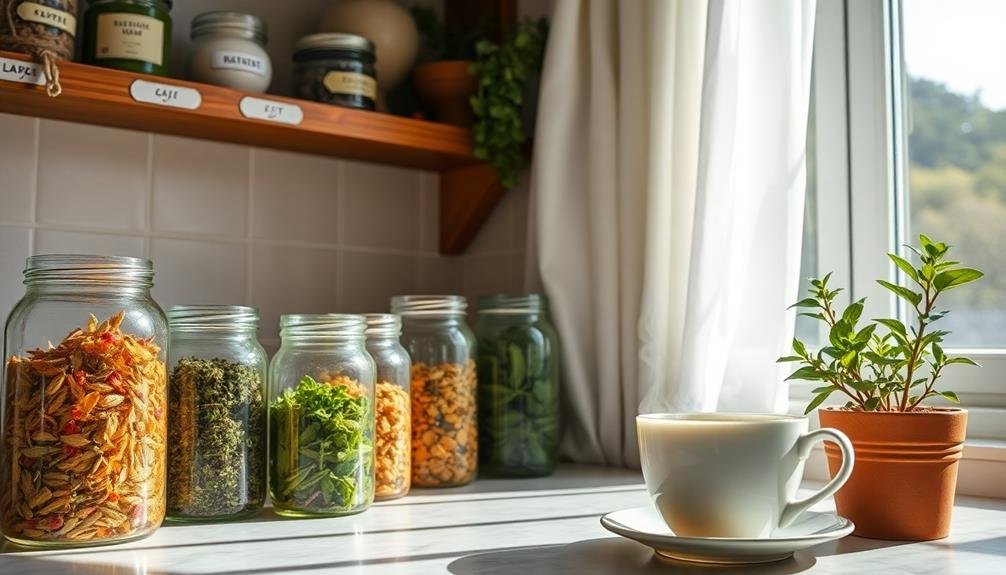
Proper storage is essential for preserving the flavor and potency of your herbal tea. To keep your infusions fresh, choose a cool, dark place away from heat and moisture. A pantry or cupboard works well, but avoid areas near stoves or windows where sunlight can degrade the herbs.
Use airtight containers made of glass or opaque materials to shield your tea from air exposure. If you're using bags, make certain they're sealed tightly after each use. This helps prevent the essential oils from escaping, which can diminish the flavor profile over time.
Label your containers with the type of tea and the date of purchase. Most herbal teas enjoy their peak freshness within six months to a year, so keeping track will help you use them before they lose potency.
If you've made an infusion, store it in the refrigerator and consume it within a few days to enjoy the maximum health benefits.
Frequently Asked Questions
Are There Any Side Effects From Herbal Infusions?
Yes, herbal infusions can have side effects. You might experience allergies, digestive issues, or interactions with medications. It's important to consult a healthcare professional before trying new herbal remedies to avoid potential complications.
Can Children Drink Antioxidant-Packed Herb Infusions?
Yes, children can drink antioxidant-packed herb infusions, but it's best to consult a pediatrician first. They'll help you determine the right types and amounts to guarantee your child enjoys the benefits safely.
How Often Should I Drink These Infusions?
You should drink antioxidant-packed herb infusions daily for ideal benefits. Start with one cup, then adjust based on your body's response. Consistency helps you maximize the positive effects on your overall wellness. Enjoy!
Are There Any Allergies Associated With Herbal Ingredients?
Yes, some people have allergies to herbal ingredients. It's essential you check for specific allergens in the herbs you're using. Always consult a healthcare professional if you have a history of allergies or sensitivities.
Can I Use Dried Herbs Instead of Fresh Ones?
You can definitely use dried herbs instead of fresh ones. They're convenient and have a longer shelf life. Just remember, dried herbs are more potent, so you might need less to achieve the same flavor.
In Summary
Choosing antioxidant-packed herb infusions for your wellness routine is a flavorful and beneficial decision. These infusions not only provide robust health benefits but also allow you to explore unique flavor combinations. By experimenting with different blends and brewing techniques, you can enjoy a personalized experience that supports your well-being. So, embrace the power of herbal teas, store them properly, and savor each sip as a step toward a healthier you. Your body will thank you!


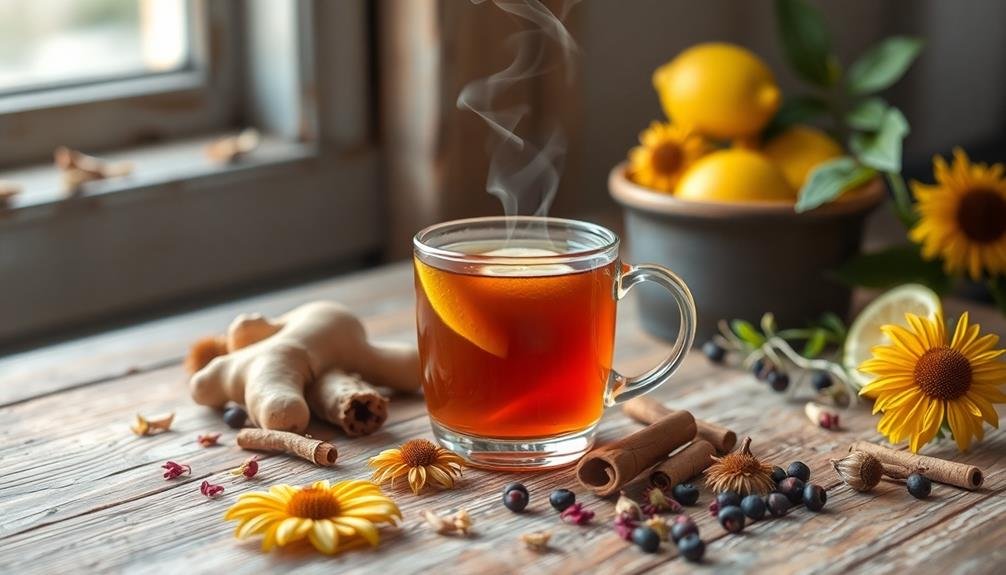
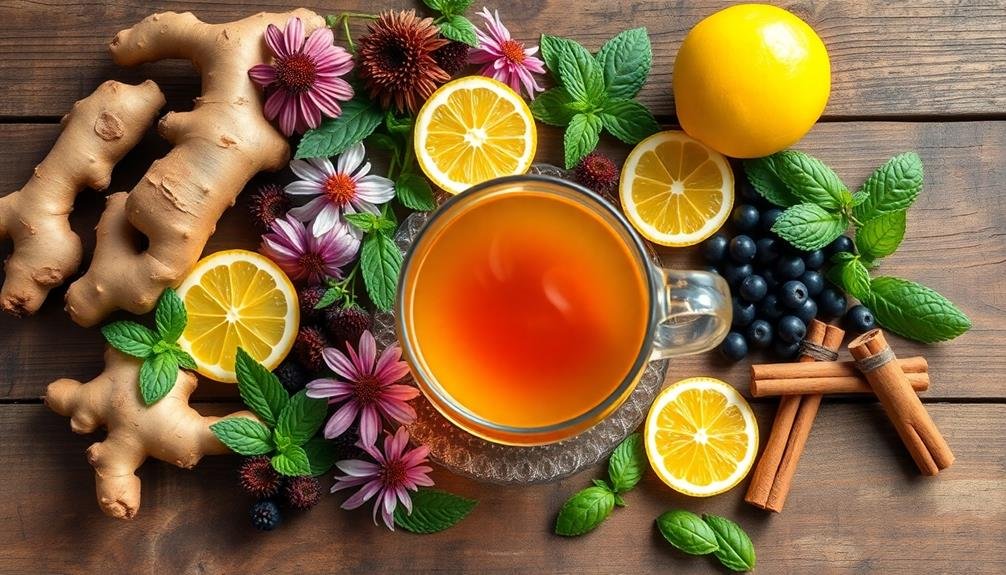
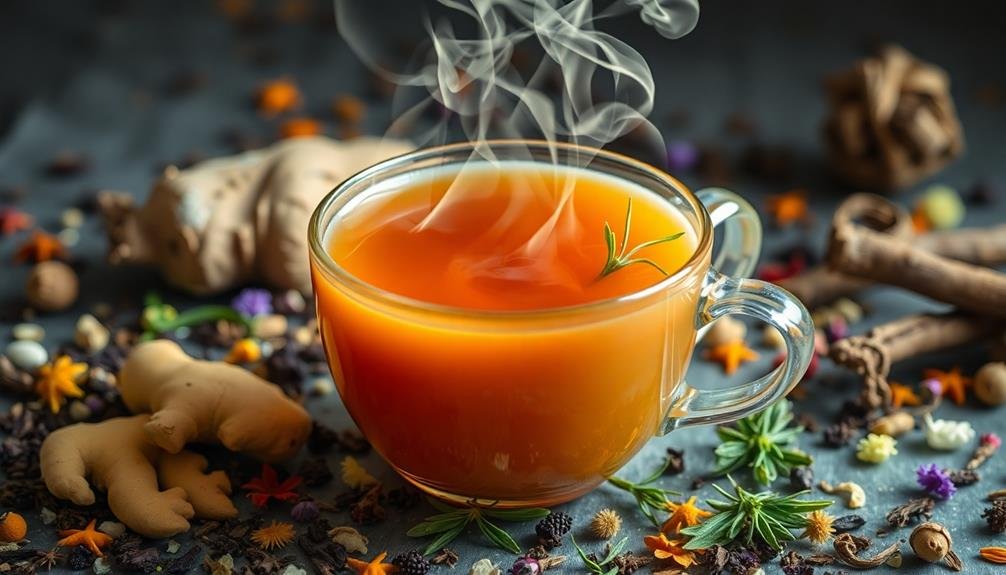
Leave a Reply